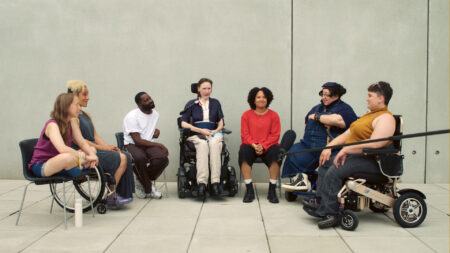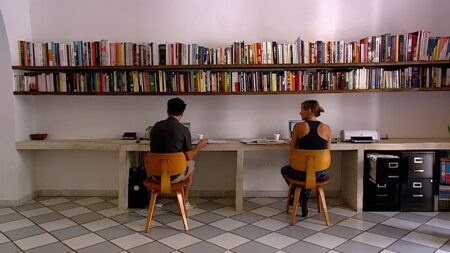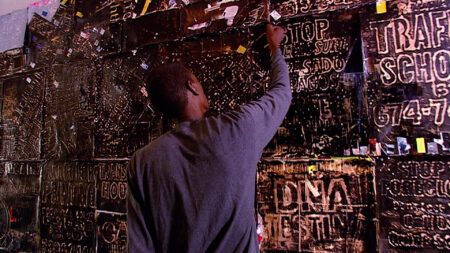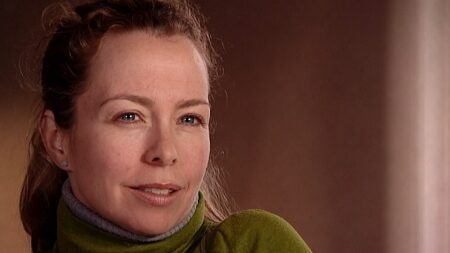Continue playing
(Time remaining: )
Play from beginning
Continue playing "{{ controller.videos[controller.getVideo(controller.currentVideo)].segmentParentTitle}}"
{{controller.videos[controller.getVideo(controller.currentVideo)].title}} has ended.
Robert Ryman in "Paradox"
Growing up in Nashville, Robert Ryman had a strong interest in music. A bebop musician in his youth, Ryman’s musical knowledge influenced his work as a painter. His approach to learning an instrument was applied to painting: “I thought the painting should just be about what it’s about…”
“In all of my paintings, I discover things,” says the artist, “Sometimes I’m surprised at the result, but I know what I’m doing.” Ryman does not use assistants and prefers to work alone. Using white paint on square forms, he creates works such as Philadelphia Prototype, highlighting the subtle nuances of a surface and exploring the role that context and perception play in a visual experience.
Credits
Created by: Susan Sollins & Susan Dowling. Executive Producer & Curator: Susan Sollins. Series Producer: Eve-Laure Moros Ortega. Associate Producer: Migs Wright. Associate Curator: Wesley Miller. Production Manager: Alice Bertoni & Nick Ravich. Production Coordinator: Amanda Donnan & Meredith Klein. Consulting Director: Charles Atlas. Editor: Monte Matteotti. Director of Photography: Terry Doe, Bob Elfstrom, Mark Falstad, Mead Hunt, Joel Shapiro, & Abdiel Vivancos. Additional Photography: Rodrigo Menck, Nick Ravich, Miguel Sanchez-Martin, & Sergio Zeigler. Sound: Tom Bergin, Ray Day, Ron Garson, Heidi Hesse, Henry Lopez, Roger Phenix, Adilson Tatu, & Merce Williams. Audio Technician: Nick Baumhardt & Drew Weir. Assistant Camera: César Caldas, Luke Deikis, Craig Feldman, Brian Hwang, Agnes Jammal, & Michael Pruitt-Bruun. Field Producer: Glenn DuBose & Mariana Valdrighi Amaral. Production Assistant: David Gonzalez, Steve Lynn, Justyna Rutkowska, & Edward Shen. Additional Animation: Joaquin Perez.
Creative Consultant: Ed Sherin. Art Direction & Design: Open, New York. On-Line Editor: Don Wyllie. Composer: Peter Foley. Voice-Over Artist: Jace Alexander. Sound Editing: Margaret Crimmins & Greg Smith. Sound Mix: Cory Melious & Tony Volante. Animation Stand: Frank Ferrigno. Assistant Editor: Ahmed Amer, Jennifer Chiurco, & George Panos.
Artworks Courtesy of: Jennifer Allora & Guillermo Calzadilla; Mark Bradford; Robert Ryman; Catherine Sullivan; Galerie Chantal Crousel, Paris; Galleria Gio’ Marconi, Milan; Metro Pictures, New York; The Moore Space, Miami; PaceWildenstein, New York; The Pennsylvania Academy of Fine Arts, Philadelphia; & Sikkema Jenkins & Co., New York. Archival Footage Courtesy of: Jennifer Allora & Guillermo Calzadilla; & Mark Bradford. Archival Photographs Courtesy of: Sidney B. Felsen, Gemini G.E.L, Los Angeles.
Special Thanks: Carlotta Arlango; The Art21 Board of Trustees; Carlos Avendano; Alexander Baker; Amy Baker Sandback; Joanna Baranowska; Larry Becker; Bienal de São Paulo; Monique Birault; Lara Blanchy; Stephen Bozler; Ellie Bronson; Laurie Butler; Pat Casteel; Collection Lambert, Avignon; Elodie Collen; Dog Bark Sound; Susan Dunne; Frame:Runner NYC; Hilda Frontanes Suarez; Arne Glimcher; Pascal Guillermin; Carolin Hochleichter; Michael Jenkins; Jennifer Joy; Silvia Karman Cubiñá; Barbara Katus; Meredith Klein; My Linh Miles; Los Angeles County Museum of Art; Dominic Mercier; My Linh Miles; Mobile Academy, Warsaw; Patches Sound; Cheryle Robertson; Amy Baker Sandback; Mônica Shiroma de Carvalho; Sound Lounge; Alessandro Thompson; Vagabond Audio; Tennia Williams; James Woodward; Steve Wylie; & Ibett Yáñez.
Director of Education & Public Programs: Tana Hargest. Education Consultant: Jessica Hamlin. Manager of Public Programs & Outreach: Kelly Shindler. Web Producer: Ana Otero. Senior Development Officer: Beth Allen. Development Associate: Sara Simonson. Development Coordinator: Erin Cesta & Katherine Payne.
Interns: Stephanie Abraitis, Alex Agnant, Gabriella della Croce, Nora Herting, Milena Hoegsberg, Rives Kitchell, Katie McCurry, Simone Otenaike, Karoline Pfeiffer, Nick Pozek, Carolina Puente, Muña Qamar, Bettina Riccio Henry, Meg Scally, Karen Seapker, Peter Sebeckis, Lucy Strong, & Kelly Williamson.
Public Relations: Goodman Media International. Station Relations: De Shields Associates, Inc. Legal Counsel: Albert Gottesman. Bookkeeper: Marea Alverio-Chaveco & Valerie Riley. Travel Agent: Lita Gottesman.
Major underwriting for Season 4 of Art in the Twenty-First Century is provided by National Endowment for the Arts, PBS, Agnes Gund and Daniel Shapiro, Nathan Cummings Foundation, Bloomberg, The Andy Warhol Foundation for the Visual Arts, The Horace W. Goldsmith Foundation, Bagley Wright Fund, and W.L.S. Spencer Foundation.
Closed captionsAvailable in English, German, Romanian, Italian, Japanese, Korean, Chinese, Italian
Through the Art21 Translation Project, multilingual audiences from around the globe can contribute translations, making Art21 films more accessible worldwide. Translate this video now.
Interested in showing this film in an exhibition or public screening? To license this video please visit Licensing & Reproduction.
Robert Ryman’s work explodes the classical distinctions between art as object and as surface—between sculpture and painting, between structure and ornament—emphasizing instead the role that perception and context play in creating an aesthetic experience. Ryman isolates the most basic of components (material, scale, and support), enforcing limitations that allow the viewer to focus on the physical presence of the work in space. Since the 1950s, Ryman has used primarily white paint on a square surface while harnessing the nuanced effects of light and shadow to animate his work. Neither abstract nor entirely monochromatic, Ryman’s paintings are paradoxically “realist” according to the artist’s own lexicon.
“I thought the painting should just be about what it’s about… In all of my paintings, I discover things. Sometimes I’m surprised at the result, but I know what I’m doing.”
Robert Ryman





